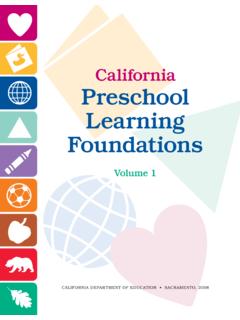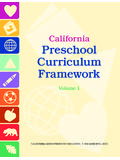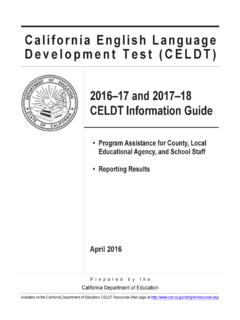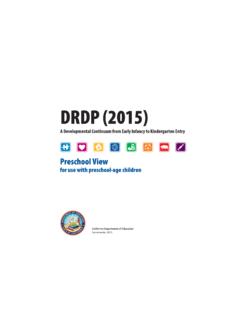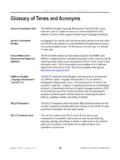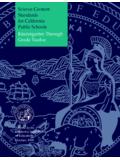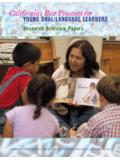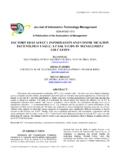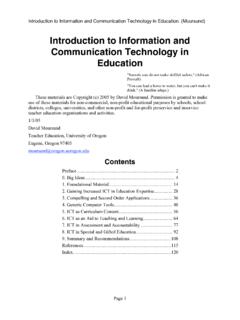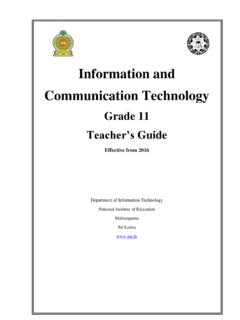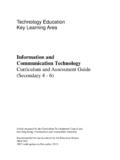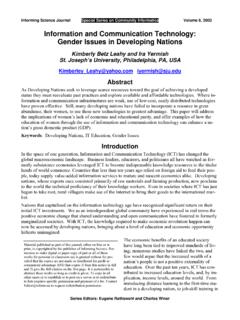Transcription of California Career Technical Education Model …
1 information and communication TechnologiesInformation Support and ServicesSoftware and Systems DevelopmentGames and SimulationNetworkingCalifornia Career Technical Education Model Curriculum StandardsTable of ContentsInformation and communication TechnologiesOverview .. iiiCalifornia Standards for Career Ready Practice .. viSector Description ..1 Knowledge and Performance Anchor Standards .. Academics .. Communications .. Career Planning and Management .. technology .. Problem Solving and Critical Thinking .. Health and Safety .. Responsibility and Flexibility .. Ethics and Legal Responsibilities .. Leadership and Teamwork .. Technical Knowledge and Skills .. Demonstration and Application .. 7 Pathway Standards ..8A. information Support and Services Pathway .. 8B. Networking Pathway .. 11C. Software and Systems Development Pathway ..14D. Games and Simulation Pathway ..18 Academic Alignment Matrix ..21 Contributors.
2 35 References ..36 ICT| California Career Technical Education Model Curriculum StandardsiiOverviewThe Career Technical Education (CTE) Model Curriculum Standards publication is organized for use as a complete document or for access to individual industry sectors and pathways. The document includes Standards for Career Ready Practice which describe the knowledge and skills that students need prior to entering a Career Technical Education program as part of the Career Technical educa-tion sequence or as integrated elements of other course work in preparation for careers and of the 15 industry sector sections includes a description, anchor standards, pathway standards, and an academic alignment matrix. The standards can be adjusted to be part of the curriculum (grades seven through twelve), provided through adult Education , or included in community col-lege programs. The document also lists the representatives who participated in each sector s content development and the references that were consulted to revise the CTE standards.
3 Standards for Career Ready PracticeCalifornia s Standards for Career Ready Practice, which follow this overview, are based on the Career Ready Practices of the Common Career Technical Core (CCTC), a state-led initiative sponsored by the National Association of State Directors of Career Technical Education Consortium (NASDCTEc): Career Ready Practices describe the Career -ready skills that educators should seek to develop in their students. These practices are not exclusive to a Career Pathway, program of study, discipline or level of Education . Career Ready Practices should be taught and reinforced in all Career exploration and preparation programs with increasingly higher levels of complexity and expectation as a student advances through a program of study. (NASDCTEc 2012, 2) California s 12 Standards for Career Ready Practice align with the state s CTE anchor standards and reflect the expectations from business and industry, labor and community organizations, and second-ary and postsecondary Education representatives from 42 participating StandardsThe 11 anchor standards build on the Standards for Career Ready Practice and are common across the 15 industry sectors.
4 Content for these standards was drawn from several documents: Preparing Students for the 21st Century Economy (American Association of Colleges for Teacher Education and the Partnership for 21st Century Skills 2010); How Should Colleges Prepare Students to Succeed in Today s Global Economy? (Association of American Colleges and Universities and Peter D. Hart Research Associates, Inc. 2006); Importance of Skills and Knowledge for College and Career Readiness, from The MetLife Survey of the American Teacher: Preparing Students for College and Careers (MetLife, Inc. 2011); and Are They Really Ready to Work? Employers Perspectives on the Basic Knowledge and Applied Skills of New Entrants to the 21st Century Workforce (The Conference Board et al. 2006).Each anchor standard is followed by performance indicators using action verbs from the Beyond Knowledge Construct, presented in a hierarchical progression of simple tasks to more complex tasks. Performance indicators provide guidance for curriculum design and standards measurement.
5 | information and communication Technologies ICTiiiICT | California Career Technical Education Model Curriculum StandardsThe industry-sector anchor standards have been customized with selected additions to better reflect the needs and special conditions of each industry Standard 1 (Academics) guides users to sector-specific core academic standards related to each industry sector, which are listed in the alignment matrix at the end of each sector section. Anchor standards 2 10 are deliberately aligned with one of the Common Core English language arts standards, using similar language demonstrating the natural connections between the two subjects. Anchor Standard 11 (Demonstration and Application) highlights classroom, laboratory, and workplace learning specific to the individual sector and StandardsAll 15 industry sectors contain multiple pathways. In order to be identified and listed for an industry sector, each pathway had to meet the following criteria: unique to an industry sector has an occupational focus consistent in size and scope composed of similar functions inclusive of all aspects of the industry includes 8 12 pathway-specific standards demonstrates sequence potential reasonable and appropriate for high school leads to high-skill, high-wage, or high-demand jobs sustainable and viable over the next 10 yearsAcademic Alignment MatrixEach sector includes an academic alignment matrix that displays where a natural, obvious alignment occurs.
6 Compiled by five teams of academic content experts in collaboration with industry-sector consultants, teachers, and other advisers, the alignment was selected if it was determined that the pathway standard would enhance, reinforce, or provide an application for a specific academic subject alignment matrices include the subjects of Common Core English language arts and mathemat-ics standards, history/social studies standards, and Next Generation Science Core Ideas. To assist with further review and implementation, each academic alignment is notated with specific pathway standards and communication Technologies | ICTI mplementationThe Standards for Career Ready Practice can be integrated with a course or incorporated into several courses over multiple school years (grades seven through twelve). The practices are expectations for all students, whether they are enrolled in a CTE program or following a more generalized course sequence. It is expected that all students who exit high school will be proficient in these anchor standards are the basis for each of the pathways within each sector.
7 These standards are designed to assist with the development of course curricula and instructional lesson plans; they describe what is to be taught and measured. In most cases, the teacher determines the sequence and strategies to be used to meet the needs of the student population he or she is performance indicators that follow each standard offer guidance for both course design and student assessment. They are intended to guide course work as it is developed. The pathways organize the standards with a Career focus, but they are not designed to be offered as single courses. Rather, the standards from each pathway are collected and organized into a sequence of learning. To meet local demands of business and industry and particular student populations, standards can be collected from more than one sector to create a the academic alignment matrices as a resource, academic and CTE teachers can see where enhancements and support for both sets of standards can be initiated. CTE teachers can quickly iden-tify academic standards that have a substantial relationship to their instruction.
8 Likewise, academic teachers can specify individual academic standards and quickly identify related CTE standards, which will assist them in incorporating application and technology in their curricula and CTE Model Curriculum Standards are intended to serve the entire Education community from middle schools and high schools to postsecondary colleges and Career training programs. A major aim of these standards is to prepare students for postsecondary Education and training and to help them make a smooth transition into the workforce. In order for both the people and the economy of Cali-fornia to prosper, it is essential for all students to emerge from schools ready to pursue their Career and college goals. Equipping all high school students with the knowledge and skills necessary to plan and manage their Education and careers throughout their lives will help to guarantee these important outcomes. Strong CTE programs will continue to provide important educational opportunities to assist students as they pursue their dreams and strive for economic prosperity.
9 The CTE Model Curriculum Standards are a resource for educators and the business world for ensuring high-quality CTE learning experiences and improved student outcomes in the twenty-first-century | California Career Technical Education Model Curriculum StandardsCalifornia Standards for Career Ready PracticeStandards for Career Ready Practice describe the fundamental knowledge and skills that a Career -ready student needs in order to prepare for transition to postsecondary Education , Career training, or the workforce. These standards are not exclusive to a Career pathway, a CTE program of study, a par-ticular discipline, or level of Education . Standards for Career Ready Practice are taught and reinforced in all Career exploration and preparation programs with increasingly higher levels of complexity and expectation as a student advances through a program of study. Standards for Career Ready Practice are a valuable resource to CTE and academic teachers designing curricula and lessons in order to teach and reinforce the Career -ready aims of the CTE Model Curriculum Standards and the Common Core State Apply appropriate Technical skills and academic individuals readily access and use the knowledge and skills acquired through experience and Education .
10 They make connections between abstract concepts with real-world applications and recognize the value of academic preparation for solving problems, communicating with others, calcu-lating measures, and other work-related practices. 2. Communicate clearly, effectively, and with individuals communicate thoughts, ideas, and action plans with clarity, using written, verbal, electronic, and/or visual methods. They are skilled at interacting with others, are active listen-ers who speak clearly and with purpose, and are comfortable with the terminology common to the workplace environment. Career -ready individuals consider the audience for their communication and prepare accordingly to ensure the desired outcome. 3. Develop an Education and Career plan aligned with personal individuals take personal ownership of their own educational and Career goals and man-age their individual plan to attain these goals. They recognize the value of each step in the educa-tional and experiential process and understand that nearly all Career paths require ongoing Education and experience to adapt to practices, procedures, and expectations of an ever-changing work envi-ronment.
